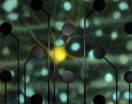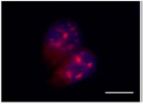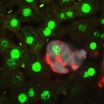(Press-News.org) Proteins are responsible for the vast majority of the cellular functions that shape life, but like guests at a crowded dinner party, they interact transiently and in complex networks, making it difficult to determine which specific interactions are most important.
Now, researchers from the University of Chicago have pioneered a new technique to simplify the study of protein networks and identify the importance of individual protein interactions. By designing synthetic proteins that can only interact with a pre-determined partner, and introducing them into cells, the team revealed a key interaction that regulates the ability of embryonic stem cells to change into other cell types. They describe their findings June 5 in Molecular Cell.
"Our work suggests that the apparent complexity of protein networks is deceiving, and that a circuit involving a small number of proteins might control each cellular function," said senior author Shohei Koide, PhD, professor of biochemistry & molecular biophysics at the University of Chicago.
For a cell to perform biological functions and respond to the environment, proteins must interact with one another in immensely complex networks, which when diagrammed can resemble a subway map out of a nightmare. These networks have traditionally been studied by removing a protein of interest through genetic engineering and observing whether the removal destroys the function of interest or not. However, this does not provide information on the importance of specific protein-to-protein interactions.
To approach this challenge, Koide and his team pioneered a new technique that they dub "directed network wiring." Studying mouse embryonic stem cells, they removed Grb2, a protein essential to the ability of the stem cell to transform into other cell types, from the cells. The researchers then designed synthetic versions of Grb2 that could only interact with one protein from a pool of dozens that normal Grb2 is known to network with. The team then introduced these synthetic proteins back into the cell to see which specific interactions would restore the stem cell's transformative abilities.
"The name, 'directed network wiring,' comes from the fact that we create minimalist networks," Koide said. "We first remove all communication lines associated with a protein of interest and add back a single line. It is analysis by addition."
Despite the complexity of the protein network associated with stem cell development, the team discovered that restoring only one interaction—between Grb2 and a protein known as Ptpn11/Shp2 phosphatase—was enough to allow stem cells to again change into other cell types.
"We were really surprised to find that consolidating many interactions down to a single particular connection for the protein was sufficient to support development of the cells to the next stage, which involves many complicated processes," Koide said. "Our results show that signals travel discrete and simple routes in the cell."
Koide and his team are now working on streamlining directed network wiring and applying it to other areas of study such as cancer. With the ability to dramatically simplify how scientists study protein interaction networks, they hope to open the door to new research areas and therapeutic approaches.
"We can now design synthetic proteins that are far more sophisticated than natural ones, and use such super-performance proteins toward advancing science and medicine," he said.
INFORMATION:
The study, "Directed network wiring identifies a key protein interaction in embryonic stem cell differentiation," was supported by the National Institutes of Health. Additional authors include Norihisa Yasui, Greg M. Findlay, Gerald D. Gish, Marilyn S. Hsiung, Jin Huang, Monika Tucholska, Lorne Taylor, Louis Smith, W. Clifford Boldridge, Akiko Koide and Tony Pawson.
New method reveals single protein interaction key to embryonic stem cell differentiation
2014-06-05
ELSE PRESS RELEASES FROM THIS DATE:
Research helps clarify how obesity leads to type 2 diabetes, cancer
2014-06-05
New findings about the biological links between obesity, insulin resistance and type 2 diabetes may also shed light on the connection between obesity and cancer, says a scientist at The University of Texas at Dallas.
In a study published online June 5 in the journal Cell, UT Dallas' Dr. Jung-whan (Jay) Kim and colleagues at the University of California, San Diego found that a protein called HIF-1 alpha plays a key role in the development of insulin resistance and type 2 diabetes in obese mice.
The researchers genetically engineered mice to lack the HIF-1 alpha protein ...
New research explains how we use the GPS inside our brain to navigate
2014-06-05
The way we navigate from A to B is controlled by two brain regions which track the distance to our destination, according to new research funded by the Wellcome Trust and published in Current Biology.
The study found that at the beginning of a journey, one region of the brain calculates the straight-line to the destination ('the distance as a crow flies'), but during travel a different area of the brain computes the precise distance along the path to get there.
The findings pinpoint the precise brain regions used and in doing so change how scientists believed we use ...
Our own treacherous immune genes can cause cancer after viral infection
2014-06-05
HPV (human papillomavirus) infection is widely known to induce cancer. Many of the mutations that cause this virally-induced cancer are caused by a family of genes that normally combats viral infections, finds new UCL (University College London) research.
This raises the possibility of developing drugs to regulate the activity of these genes to prevent HPV-associated cancers from developing and reduce the ability of existing cancers to evolve resistance to treatments.
The research, published in Cell Reports, shows for the first time that genes from the 'APOBEC' family, ...
Cellular traffic control system mapped for the first time
2014-06-05
Cells must transport nutrients and messenger cargos through its membrane and transport them within the cell at the correct time and place. This procedure is complex and is regulated with the help of specific genes. If disturbances in the transport mechanism arise, severe diseases, such as diabetes, cancer and diverse neurological pathologies, are the consequence. The discovery of the molecular principles of cellular transport was honored with the Nobel Prize of physiology and medicine in 2013. While knowing the intracellular roads and the functioning of the cars that use ...
Unmasking viral invaders
2014-06-05
If you have it, you probably don't know it. Cytomegalovirus, or CMV, is perhaps one of the biggest pathogens you've never heard of—big, both proportionately and epidemiologically. It contains approximately 200 genes, compared to HIV's paltry 18, and it's everywhere. You can catch it as a preschooler salivating over blocks, or as a teenager experiencing your first kiss. Once you have it, you have it for life.
Good news: If you're healthy, it's harmless. Your T cells keep it in check, and you'll be none the wiser.
Bad news: If you have any medical condition that dampens ...
Making artificial vision look more natural
2014-06-05
In laboratory tests, researchers have used electrical stimulation of retinal cells to produce the same patterns of activity that occur when the retina sees a moving object. Although more work remains, this is a step toward restoring natural, high-fidelity vision to blind people, the researchers say. The work was funded in part by the National Institutes of Health.
Just 20 years ago, bionic vision was more a science fiction cliché than a realistic medical goal. But in the past few years, the first artificial vision technology has come on the market in the United States ...
Discovered a new way to control genetic material altered in cancer
2014-06-05
When we talk about genetic material, we are usually referring to the DNA (deoxyribonucleic acid) that we inherit from our parents. This DNA is the factory where is built a similar molecule called RNA (ribonucleic acid) which produces our proteins, such as hemoglobin or insulin , allowing the lives of our cells. But there is a special group called non-coding RNA that has a more enigmatic function.
The best known is microRNAs, tiny molecules that are responsible for turning on or off our genome like an electrical current switch. Today, an article published in the prestigious ...
A new model of liver regeneration
2014-06-05
Harvard Stem Cell Institute scientists at Boston Children's Hospital have new evidence in mice that it may be possible to repair a chronically diseased liver by forcing mature liver cells to revert back to a stem cell-like state.
The researchers, led by Fernando Camargo, PhD, happened upon this discovery while investigating whether a biochemical cascade called Hippo, which controls how big the liver grows, also affects cell fate. The unexpected answer, published in the journal Cell, is that switching off the Hippo-signaling pathway in mature liver cells generates very ...
Vanderbilt scientists discover that chemical element bromine is essential to human life
2014-06-05
Twenty-seven chemical elements are considered to be essential for human life.
Now there is a 28th – bromine.
In a paper published Thursday by the journal Cell, Vanderbilt University researchers establish for the first time that bromine, among the 92 naturally-occurring chemical elements in the universe, is the 28th element essential for tissue development in all animals, from primitive sea creatures to humans.
"Without bromine, there are no animals. That's the discovery," said Billy Hudson, Ph.D., the paper's senior author and Elliott V. Newman Professor of Medicine.
The ...
Flowers' polarization patterns help bees find food
2014-06-05
Like many other insect pollinators, bees find their way around by using a polarization sensitive area in their eyes to 'see' skylight polarization patterns. However, while other insects are known to use such sensitivity to identify appropriate habitats, locate suitable sites to lay their eggs and find food, a non-navigation function for polarization vision has never been identified in bees – until now.
Professor Julian Partridge, from Bristol's School of Biological Sciences and the School of Animal Biology at the University of Western Australia, with his Bristol-based ...



